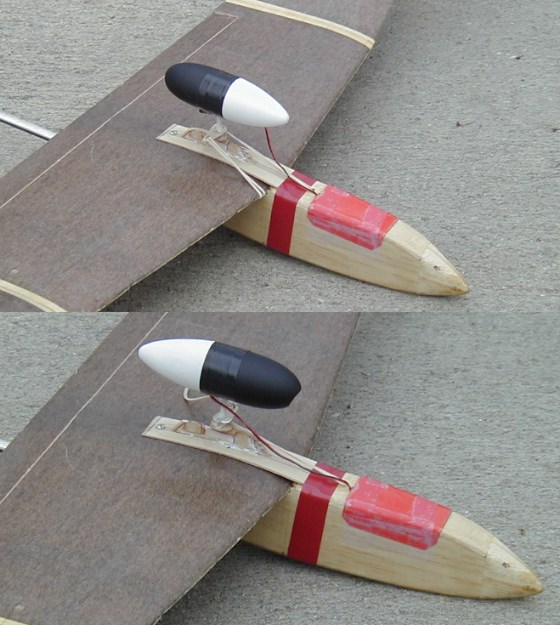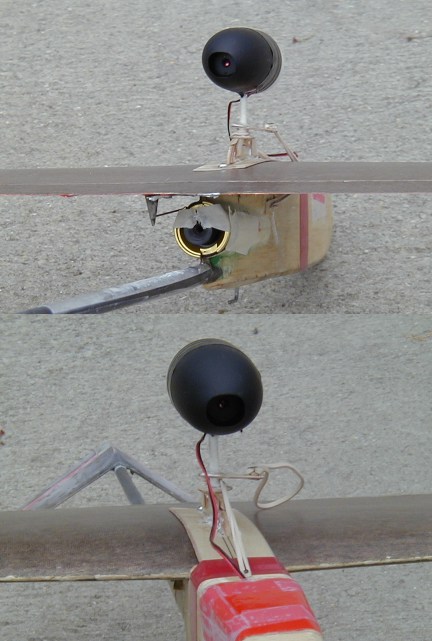Regarding my Cuda R/C R/G with the rotating camera pod:
The trigger was a 3rd servo that the model originally used for controlling a Flap, to help with S8E/P spot landings.
I rigged the 3rd servo to simply retract a 1/32" diameter rod from being about 3/8" external, to retract slightly inside of the outer fuselage surface. That released a rubber band that had been holding the pod to look rearward.
Another rubber band then rotated the pod 180 degrees. Leverage was arranged so that band had less leverage to rotate it, while the hold-back band had more leverage. You can see an arm that the hold-back band used for leverage. The pod itself was free to rotate, using 1/16" music wire rotating inside of some plastic tubing of a bit more than 1/16" ID.
At the time, the only servos I knew of rotated about 90 degrees. Now, there are servos that rotate 180 degrees. So, if I flew that same model today, I'd rebuild the camera mount to use a 180 degree servo. So then I could rotate it front, back, to one side, and would be able to move it back and forth in any direction, no one-shot like the original. Also I'd use a Keychain cam, as the limited range and ground equipment needs of the Gearcam were a hassle (You will note some loss of signal gaps in the video).
Of course, I'd really like to get into FPV, First Person View. Well, I could have sort of done that with the Gearcam, but I could not have trusted it. And I never had a big screen I could really see real-time to pilot the model with. I'd want to do FPV with video goggles. I have seen really neat onboard airplane FPV videos where a 180 degree servo is rotating the camera from side to side (and also in pitch), often commanded by head-tracking sensors (usually in FPV video goggles) that point the servo the direction the pilot turns his head.
For now, if I want to have an onboard camera to look forward, and look back, it is simpler to just tape two keychain cameras onboard looking those directions. Barely noticeable in that video, in the tail view, about 1 second before the camera flipped, smoke from a forest fire miles away was coming into view to the left of the screen. If it had had two cameras, it would have gotten good footage of that forest fire smoke.
OK, two more videos, both from the same flight. My Orbital SkyDart Project, OSP.
[youtube]CjiYWL0AzjA[/youtube]
[youtube]FW8IqppJnUY[/youtube]
https://georgesrockets.com/GRP/video/Airvid/SkyDart_video.htm
The pilot flying the Skydart was not too skilled with aileron models. But it also turned out something was screwy with the elevons. For the SkyBooster, I flew that, and fired the E9 manually by R/C to stage the SkyDart. The SkyBooster was a bit tail-heavy, so that is why it "mushed" around a lot. The water seen trickling along the wing leading edge is from the water ballast in the nose that leaked out during boost and 2-3 seconds into the glide. The water ballast in the nose balanced out the mass of the burning propellant in the two G12's in the tail.
- George Gassaway






